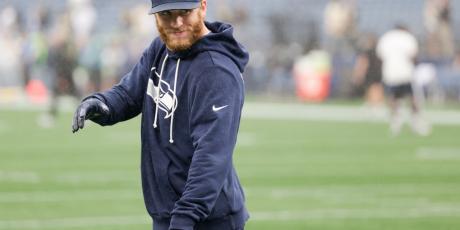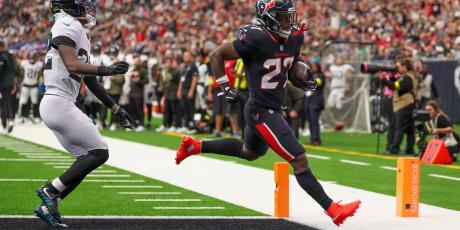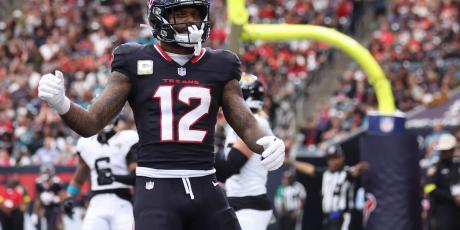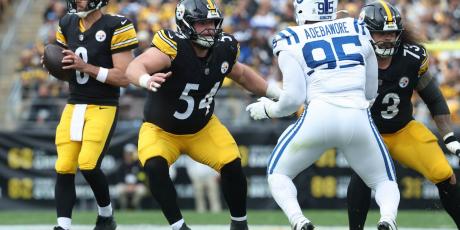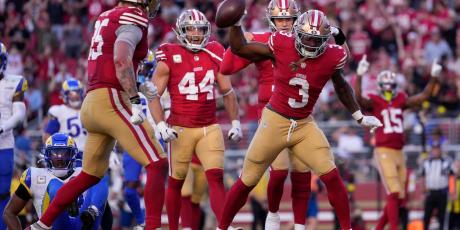Depth Chart Battle: Josh Palmer vs. Gerald Everett (Fantasy Football)
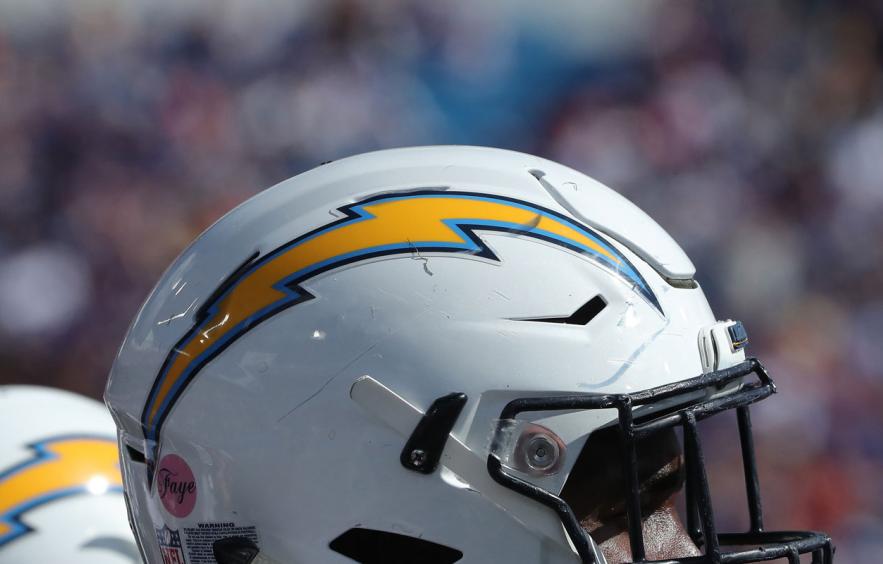
The expectations for the Los Angeles Chargers offense in 2022 are high, and deservedly so. Last season, Chargers players populated the upper portions of half-PPR fantasy scoring rankings at every single position. Quarterback Justin Herbert was fantasy's QB2 in 2021, wide receivers Keenan Allen and Mike Williams were the WR14 and the WR10 respectively, Austin Ekeler finished as the RB2, and Jared Cook was the TE17. Austin Ekeler's 94 targets were actually the third-most on the team, ahead of Jared Cook with 83 before a dropoff to Josh Palmer with 49. With Jared Cook now a free agent and Gerald Everett signed to a two-year, $12 million deal in March, the competition for receiving targets behind Allen and Williams (and potentially Ekeler) is important to parse for fantasy purposes.
Click here for more 2022 Player Profiles!
Josh Palmer (Underdog ADP 126.9, WR 57)
Out of context, one might look at Palmer's 49 targets in 2021 as a disappointing total. A closer look reveals that his target total was the fourth-highest total among all 10 wide receivers drafted in the second and third rounds of the 2021 NFL draft, behind only Elijah Moore, Rondale Moore, and Nico Collins, and Palmer landed in an offense already stacked with elite receiving options. Palmer's snap share increased as the season progressed, jumping from 23.4% in the first five games of the season to 30.2% in the next six games to 60.4% for the final stretch. Reviews from camp in 2022 have been encouraging.
From The Athletic's Daniel Popper:
"Allen and Williams are one of the best receiver duos in football. Coaches and teammates have raved about Palmer’s development as he enters Year 2, and I think he will have a firm grasp on the third receiver role by the end of training camp."
Also from Popper, from an August 17th practice:
Joshua Palmer had an outstanding period. He has always been a really sharp route runner, but his releases are dramatically improved this season. On his first rep against Dallas corner Anthony Brown, Palmer won on an out-and-up route. Herbert’s throw was short to Palmer’s back shoulder, and Palmer adjusted well to make the catch. On his second rep, Palmer stuttered his feet at the snap and got a clean release off the line against corner Isaac Taylor-Stuart, gaining leverage to the inside. He broke to the middle of the field, and Herbert hit him in stride."
Justin Herbert had a 100.4 QB rating when targeting Palmer last year, and his yards per route run (YPRR) figure was 1.3 to Jared Cook's 1.2. Palmer also caught 93.9% of his targets deemed catchable per SportsInfoSolutions and created an average separation of 2.5 yards, per NextGenStats. While Palmer's YPRR wasn't worthy of gasping and pearl-clutching, he is entering his second year in the NFL with indicators that his skills have improved, and sophomore wide receivers have the highest breakout rates.
Ultimately, Palmer's value is tied as much to target volume as it is efficiency with those targets. Fortunately for him, the Chargers lined up on offense with three wide receivers at the sixth-highest rate in the league. They also passed on 63% of their offensive snaps, which was fourth-most, and led the entire league in pace of play at 24.5 seconds per snap. Perhaps unfortunately for Palmer, The Chargers also like to target their tight ends, which stands to benefit the player I'll focus on next.
*Palmer is currently in concussion protocol but should be fine to start the season.
Gerald Everett (Underdop ADP 163.0, TE 18)
Signing Gerald Everett was a shrewd move in free agency by GM Tom Telesco, essentially replacing the departing 6'3", 248-pound Jared Cook with a younger Everett at 6'3", 239-pounds with superior agility and similar speed to Cooks.
Via Daniel Popper, when answering the question "should we expect anything new from the 2022 Chargers fantasy-wise?":
"Yes, two things. First, the Chargers replaced Jared Cook with Gerald Everettat the top of their tight end depth chart, and they hope Everett will provide a more explosive yards-after-catch dynamic at the position. They plan to get the ball in Everett’s hands in a variety of ways, from screens to flat routes to jet sweeps, and he could be poised for a career season."
And via Charger's offensive coordinator Joe Lombardi:
“The good thing about Gerald is that we kind of look at him as a complete tight end,” Lombardi said. “He’s a good blocker. He’s a good receiver. The thing that jumps out on the tape, really — because he was a free agent the last two years, so we watched him with the Rams and then in Seattle — when he gets the ball in his hands, he’s a weapon. That’s an exciting thing to add, that element. He’s a good receiver, as well. Blocker, receiver, running after the catch, there are a lot of things that we like.”
It's difficult to directly compare the 2021 production of Jared Cook and Gerald Everett given that they operated in different offenses on different teams, but there are some metrics that are informative. Everett had 1.5 YPRR to Cook's 1.2, and Seattle quarterback Russell Wilson had a 111.7 QB rating when targeting Everett compared to a 75.5 QB rating between Justin Herbert and Cook. Per SportsInfoSolutions, Everett had a broken or missed tackle per reception rate of 27.1%, which dwarfed Cook's 7.3% rate. Everett also created 4.10 yards of average separation compared to 2.80 yards for Cook, per NextGenStats, with a 76.20% catch percentage vs 57.8% for Cook. I would be remiss not to note that Cook's average depth of target was 8.3 yards compared to 5.3 yards for Everett, but that could speak more to Seattle's tight end usage than anything else.
The main reason I compare the two tight ends is to illustrate the upside of Everett in this Chargers offense. The team lined up with a single tight end on the field for 576 dropbacks in 2021, compared to just 344 dropbacks for the Seahawks. The Chargers targeted the tight end position at the ninth-highest rate overall, and no team targeted the tight end position more frequently in the red zone. Lest you think to yourself, "well, maybe it wasn't the Seahawks offense, maybe Everett would have commanded more targets if he were simply better," I would refer to Everett's season with the Rams in 2020. While his broken or missed tackle per reception rate was impressive in 2021, Everett claimed the highest rate in the league in 2020 among tight ends with at least 30 targets.
Which One Should You Draft?
Given that Josh Palmer and Gerald Everett play two different positions, why not both? The Chargers operate at a lightning-fast pace and pass at an extremely high rate, but they're also in the stacked AFC West division, where shootouts should occur with frequency. Both players project to be on the field at the same time given the Chargers' heavy usage of 11-personnel, and both should encounter exploitable coverage with Keenan Allen and Mike Williams alongside them.
I lean slightly toward Everett given his value in the 14th round, especially in redraft leagues where you can draft him as a backup that could conceivably outscore your starter. In best ball leagues, he fits as both a TE2 for drafters that managed to grab an elite tight end early or as part of a late 3-TE build on Underdog. Palmer's 11th-round ADP puts him in range of some wide receiver targets I love like Russell Gage, DeVante Parker, Jalen Tolbert, and D.J. Chark, so while I tend to prefer the potential upside of Parker and Chark as the WR1 on their respective teams, he belongs right there with Gage and Tolbert as their team's WR3 with enticing upside. Finally, stacking players on elite offenses is often a winning strategy in just about any league, and either player (or both) works quite well as a value stack with Justin Herbert.


